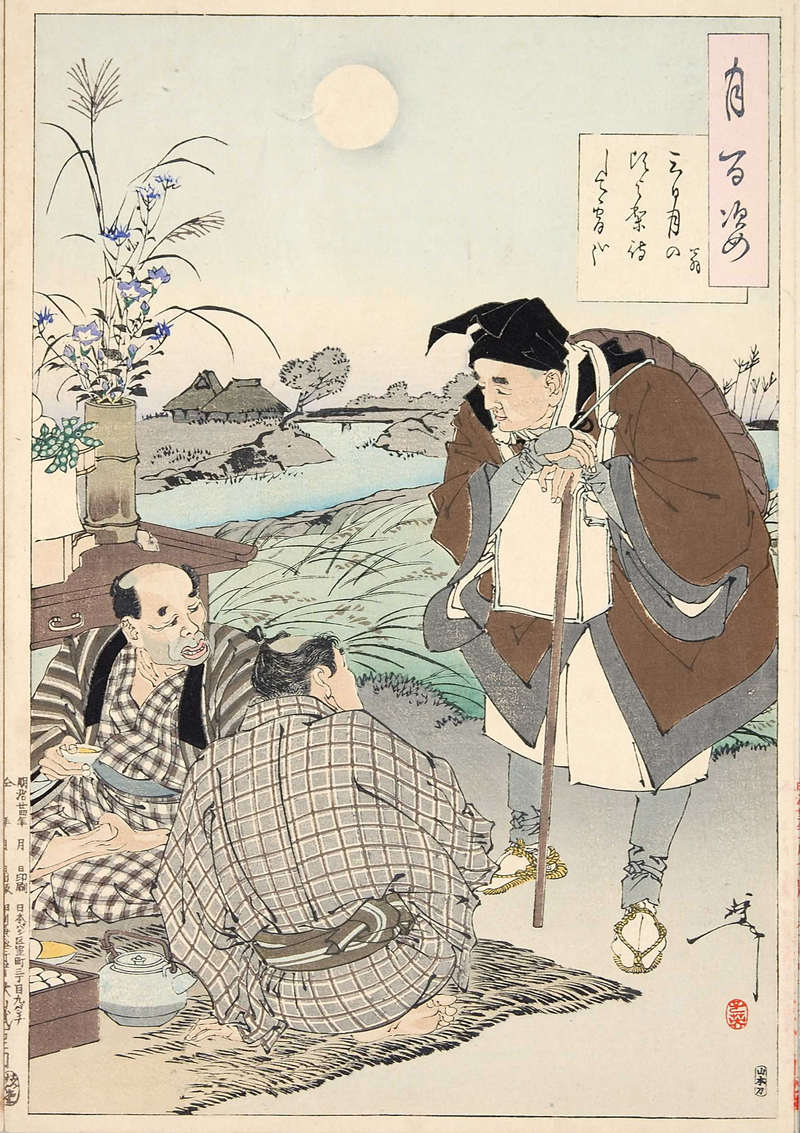A&S - Japanese Poetry and the SCA Bardic Circle
For a while, I was writing a haiku a day, minimum, and while most, as with most art, were in fact forgettable, a few were pretty good. However, there's a problem with haiku as an SCA art form: the haiku, even in its rudimentary, early form, is a post-period development. The man most associated with its early development, Matsuo Basho (note - Basho, Bashou, or Bashô is a poetic name; the Japanese have historically been very fond of nicknames; his adult name was Matsuo Munefusa) lived from 1644 to 1694, thus placing him firmly in the post-SCA period.
This led to a further exploration of Japanese poetry. It turns out that haiku specifically evolved from what was essentially a party game, very similar to the SCA bardic circle, practiced by all literate levels of society from at least the mid-1300s. This form is called renga (linked verse); the first published renga known is the Tsukubashu ("Tsukuba Anthology"), an imperial publication dated to 1356 and collected by Nijo Yoshimoto. The Tsukubashu includes both polished courtly renga, and "common" renga. The latter are sometimes shockingly vulgar, and the fact that there is a common tradition as well as a courtly tradition, and that common traditions tend to allow relaxed standards while encouraging daring on the part of the authors (see the end of this post!) means that the "common" or "comic" renga is ideally suited to the SCA bardic circle in many ways.
The basic format for renga is determined by the host, who chooses a topic - generally seasons, love, reminiscences, or religion - a length (typically a hundred stanzas for formal poetry, but shorter is much more practical for informal purposes), and the specific rules of engagement, such as the "four blossoms, eight moons" rule which specifies that at least one stanza in ten must mention flowers and one stanza in five must mention the moon, or that the poem must alternate between stanzas about black objects and white objects, or saying that specific phrases must be used once, and once only, over the course of the poem. He either writes an opening stanza, or commissions a respected poet to write an opening stanza, which differs in format from the rest of the poem, and arranges for a scribe, whose job is not to compose, but merely record, and to keep track of the rules.
The host presents the hokku - three lines in the 5-7-5 format which most westerners know - and then the other participants each contribute a verse of two lines in 7-7 format, which should be tied to the theme and the verse immediately prior, and should follow the rules. There is no time limit to a renga generally, and it is absolutely vital that renga not be competitive. Also, it is important to note that renga could be incredibly bawdy, depending on the setting, so the idea of doing it in an SCA bardic circle, where it could be a drinking game as much as a poem, is perfectly viable, so long as there is a sober scribe to record what comes out of it for posterity.
So, in summary...
Host gives the hokku
It is built in the format
Which you should all know
Scribe writes the verse and the rules
But does not also compose
Guests take their turns, each two lines
Of seven syllables for each
Renga can be simple and coarse
Or courtly and quite polished
Renga may come from the throne
But also from the dung-heap
No one person writes renga
So no one can "ruin" one
And so it goes on, again
Until the stanza limit
 |
| Pardon me, good sirs / I must ask you, if I may / Have you Grey Poupon? |
---
As an example of just how bawdy a comedic renga session could become, this is an actual fragment of a larger historical renga piece, probably written by a court official, but definitely collected in his collection "Mongrel Verses":
(Prompt from previous verse)
The robe of haze is wet at its hem
(Following line is actual verse contributed by a court calligrapher)
Princess Saho of spring pissed while standing
It is important to note that Sahohime ("Princess Saho") is the goddess of spring in this case; this was not merely shocking, but mildly blasphemous. This is important in the context of Japanese culture because we think of the Japanese as staid and reserved, and, to a certain extent, that is true; any culture crammed cheek-to-jowl tends to be. However, once they're off the clock... well, let's just say that the rowdier bardic circles I've attended would fit perfectly in the rumpus room of a Japanese contractor I once visited, and vice versa.
---
So the basic format
I have given you above
Spring is a new start
(Aaaand... go!)
Comments
Post a Comment